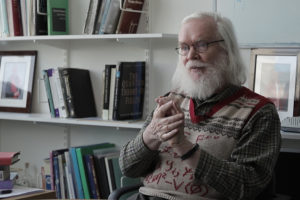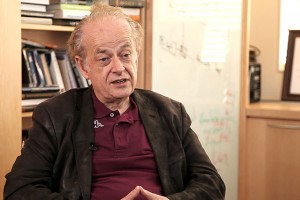Standard Model and Supersymmetry
Physicist John Ellis on the history of particle physics, the properties of the Standard model particles and wh...
Huntington’s disease is a devastating autosomal dominant neurodegenerative condition. That presents with the triad of symptoms: patients get abnormal movements, which is the most obvious symptom of it — the chorea which characterizes Huntington’s as slow writhing movements. In addition to the movement of disorder, patients develop cognitive deterioration and psychiatric manifestations. Psychiatric manifestations are a key feature of the disease. It’s not people are simply being upset because they’ve got a disease. Because this disease has autosomal dominance, half of the offspring of an affected individual on statistical grounds will be predicted to carry the mutant gene. And this disease is particularly tragic, because its median age of onset is around 40. Because its median age of onset is about 40, people until very recently found out they had the disease after they had their children. And then they were confronted with the reality that half of their children were at risk of getting the disease.
This disease has been reported in the literature for centuries, but its name — Huntington’s disease — comes from a man called George Huntington. He was an American physician who wrote up a number of cases of this disease in the 19th century. A major set of breakthroughs occurred in Huntington’s disease in the late 20th century. These are genetic breakthroughs that were enabled by the genetic revolution, the discovery of DNA and subsequent discoveries of this phenomenon called linkage. The first key breakthrough, in the genetic sense, was made by James Gusella’s group who actually mapped the Huntington’s disease gene to chromosome 4. That key event not only in Huntington’s disease [research], but in contemporary genetics, was reported in a paper in 1983.
Patients with the disease have 36 or more copies. These CAGs are in the coding part of the Huntington’s disease gene. So they represent the codon for the aminoacid glutamine. In normal individuals, who might have from 8 to 35 CAGs, there is a corresponding number of glutamins and they vary in normal individuals. In patients with the disease they have 36 or more CAGs, and a larger stretch of glutamines that are uninterrupted in the disease gene.
I mentioned earlier that the median age of onset of Huntington’s disease is 40. However, this disease can strike at any age: from very early childhood, where it’s particularly rare, to advanced age. And the age of onset in subsequent studies is shown to correlate inversely with the number of CAG repeats, or glutamines. So in patients with the very late onset the CAG repeat number is typically 36, 37, 38, 39, maybe 40. While in patients with the very early disease onset the number of repeats can be more than 55. And so there’s this inverse correlation between CAG repeat length and the age of onset.
Huntington’s disease is now known to be one of 9 diseases caused by an abnormally long polyglutamine tracks encoded by CAG trinucleotide repeats. Other examples include forms of spinocerebellar ataxia or Kennedy’s disease, otherwise known as spinal bulbar muscular atrophy. In all these diseases we see the similar relationship, the similar inverse relationship between CAG repeat lengths and the age of onset of disease. There’s extensive genetic and transgenic data arguing that the CAG repeat expansion mutations in all of these diseases cause disease primarily via toxic gain-of-function mutation. In other words, the primary consequence of the mutation is not to impair a normal function of the Huntington’s disease gene, but rather to turn it into something that’s poisonous for the cell, something foreign that’s poisonous for the cell.
It is likely that the mutant huntingtin protein causes disease by interfering with a wide range of different pathways in the cell. Therefore, maybe one needs to think of therapeutic strategies that are not going to target the downstream pathway specifically, but prevents that mutant huntingtin from doing its bad things at the source. And the most straightforward strategies for that are to try to reduce the level of the poisonous protein in the cell.
A number of strategies have been put forward that might have promise in this domain. One strategy would be to try to use RNA interference methodologies to reduce the expression of the mutant huntingtin protein. This is an approach that has been spearheaded by people like Don Cleveland, who produced beautiful data even in mouse models suggesting that antisense oligonucleotides have the capability of reducing the toxicity of the protein in mouse models. And indeed, that has led to the initiation of some clinical trials with that type of strategy in patients.
A second strategy that we’ve invested a lot in is to see if we can find ways of enhancing the removal of the mutant protein. We discovered that a process called autophagy can aid the removal of the mutant protein. Autophagy involves the formation of double membrane vesicles in the cytoplasm of cells which are then traffic to the lysosomes for degradation. These double membrane vesicles encapsulate cytoplasmic contents, and if the cell has the huntingtin protein in it can actually include the huntingtin protein for degradation. And we’ve got data now not only in cells and neurons, but also in zebrafish and mouse models, that if one can increase the rate of autophagy then one can enhance the removal of the mutant protein and ameliorate some of its toxic effects.
So what is the outlook for the future? I think, that many groups are pursuing their favorite therapeutic pathways and, as I mentioned earlier, trials have already been initiated – antisense oligonucleotides and we recently completed a safety trial with an autophagy – inducing drugs, I mean my colleague Roger Barker from Cambridge. In addition to that, there are big efforts throughout the world to understand the rate of progression of Huntington’s disease to identify biomarkers, both clinical and laboratory biomarkers that might give an indication of the progression of the disease, because these will be very powerful for clinical studies in patients.
We need to understand what the factors are that determine the rate of progression of these diseases and think more creatively about methodologies that allow us to do so. Furthermore, if we’re thinking of extrapolating understanding of Huntington’s disease to diseases like Alzheimer’s disease and Parkinson’s disease, we might need to rethink the strategy for treatment of those diseases. In other words, we might have far better biological power to attack those diseases if you could develop prophylactic therapies that actually attack the disease process prior to its onset.
So the type of analogy I like to give people is that we need to find the statin – the drug we give to prevent heart disease – the statin equivalents for neurodegenerative disease. We need to find the drugs that delay the onset of these diseases, drugs that we can give to young people that are going to be relatively benign and free of side effects, that we can use to delay the onset of the diseases. Because the best thing we can do for people who are at risk of these diseases is to buy them more years of healthy life.

Physicist John Ellis on the history of particle physics, the properties of the Standard model particles and wh...

Physicist Federico Capasso on semiconductor materials, industrial process control, and beam engineering

Neuroscientist Onur Güntürkün on depersonalization, the rubber hand illusion and how synchronous nerve impulse...